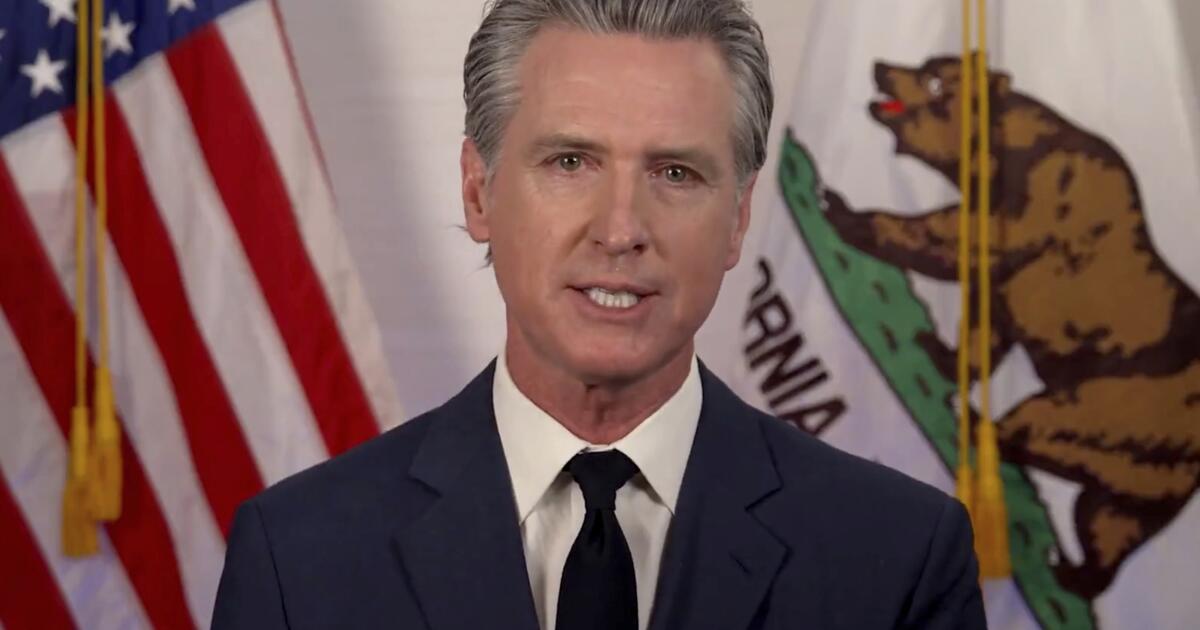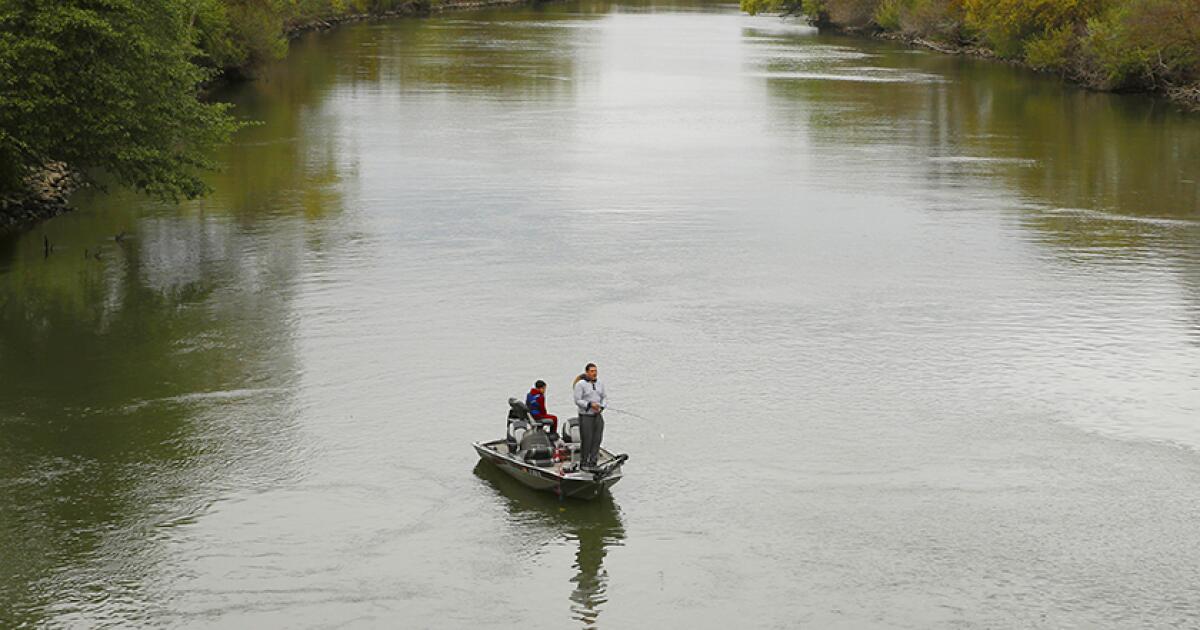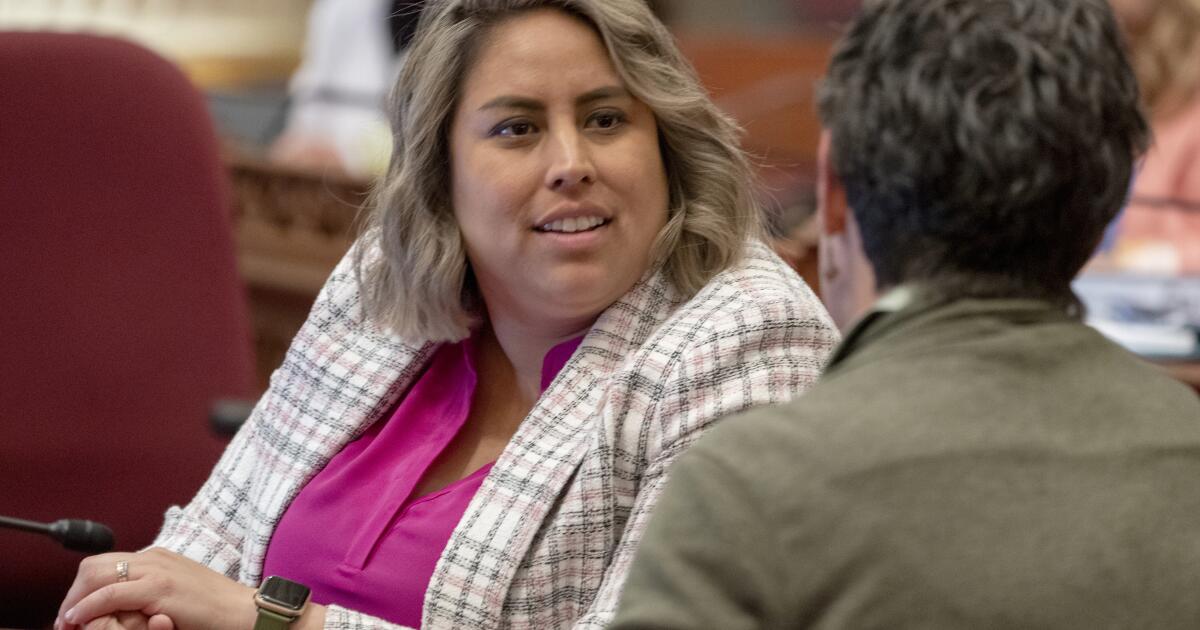Newsom’s ‘Democracy is under assault’ speech could turn the tables on Trump
Frame it as a call to action or a presidential campaign announcement, Gov. Gavin Newsom’s address to America on Tuesday has tapped into our zeitgeist (German words feel oddly appropriate at the moment) in a way few others have.
“Democracy is under assault right before our eyes,” Newsom said during a live broadcast with a California flag and the U.S. flag in the background. “The moment we’ve feared has arrived.”
What moment exactly is he referring to?
President Trump has put Marines and National Guardsmen on the streets of Los Angeles, and granted himself the power to put them anywhere. Wednesday, a top military leader said those forces could “detain” protesters, but not outright arrest them, though — despite what you see on right wing media — most protesters have been peaceful.
But every would-be authoritarian ultimately faces a decisive moment, when the fear they have generated must be enforced with action to solidify power.
The danger of that moment for the would-be king is that it is also the time when rebellion is most likely, and most likely to be effective. People wake up. In using force against his own citizens, the leader risks alienating supporters and activating resistance.
What happens next in Los Angeles between the military and protesters — which group is perceived as the aggressors — may likely determine what happens next in our democracy. If the military is the aggressor and protesters remain largely peaceful, Trump risks losing support.
If the protesters are violent, public perception could further empower Trump.
The president’s immigration czar Tom Homan, said on CNN that what happens next, “It all depends on the activities of these protesters — I mean, they make the decisions.”
Welcome to that fraught moment, America.
Who would have thought Newsom would lead on it so effectively?
“Everybody who’s not a Trumpist in this society has been taken by surprise, and is still groggy from the authoritarian offensive of the last five months,” said Steven Levitsky, a professor of government at the embattled Harvard University, and author of “How Democracies Die.”
Levitsky told me that it helps shake off that shock to have national leaders, people who others can look to and rally behind. Especially as fear nudges some into silence.
“You never know who that leader sometimes is going to be, and it may be Newsom,” Levitsky said. “Maybe his political ambitions end up converging with the small d, democratic opposition.”
Maybe. Since his address, and a coinciding and A-game funny online offensive, Newsom’s reach has skyrocketed. Millions of people watched his address, and hundreds of thousands have followed him on TikTok and other social media platforms. Searches about him on Google were up 9,700%, according to CNN. Love his message or find it laughable, it had reach — partly because it was unapologetically clear and also unexpected.
“Trump and his loyalist thrive on division because it allow them to take more power and exert even more control,” Newsom said.
I was on the ground with the protesters this week, and I can say from firsthand experience that there are a small number of agitators and a large number of peaceful protesters. But Trump has done an excellent job of creating crisis and fear by portraying events as out of the control of local and state authorities, and therefore in need of his intervention.
Republicans “need that violence to corroborate their talking points,” Mia Bloom told me. She’s an expert on extremism and a professor at Georgia State University.
Violence “like in the aftermath of George Floyd, when there was the rioting, that actually was helpful for Republicans,” she said.
Levitsky said authoritarians look for crises.
“You need an emergency, both rhetorically and legally, to engage in authoritarian behavior,” he said.
So Trump has laid a trap with his immigration sweeps in a city of immigrants to create opportunity, and Newsom has called it out.
And it calling it out — pointing out the danger of protesters turning violent and yet still calling for peaceful protest — Newsom has put Trump in a precarious position that the president may not have been expecting.
“Repressing protest is a very risky venture,” said Levitsky. “It often, not always, but often, does trigger push back.”
Levitsky points out that already, there is some evidence that Trump may have overreached, and is losing support.
A new poll by the Public Religion Research Institute found that 76% of Americans oppose the military birthday parade Trump plans on throwing for himself in Washington, D.C. this weekend. That includes disapproval from more than half of Trump supporters.
A separate poll by Quinnipiac University found that 54% of those polled disapprove of how he’s handling immigration issues, and 56% disapprove of his deportations.
Bloom warns that there’s a danger in raising too many alarms about authoritarianism right now, because we still have some functioning guardrails. She said that stoking too much fear could backfire, for Newsom and for democracy.
“We’re at a moment in which the country is very polarized and that these things are being told through two very different types of narratives, and the moment we give the other side, which was a very apocalyptic, nihilistic narrative, we give them fodder, we justify the worst policies” she said.
She pointed to the Iranian Revolution of 1979, when some protesters placed flowers in the barrels of soldiers’ guns, and act of peaceful protest she said changed public perception. That, she said, is what’s needed now.
Newsom was clear in his call for peaceful protest. But also clear that it was a call to action in a historic inflection point. We can’t know in the moment who or what history will remember, said Levitsky.
“It’s really important that the most privileged among us stand up and fight,” he said. “If they don’t, citizens are going to look around and say, ‘Well, why should I?”
Having leaders willing to be the target, when so many feel the danger of speaking out, has value, he said.
Because fear may spread like a virus, but courage is contagious, too.




